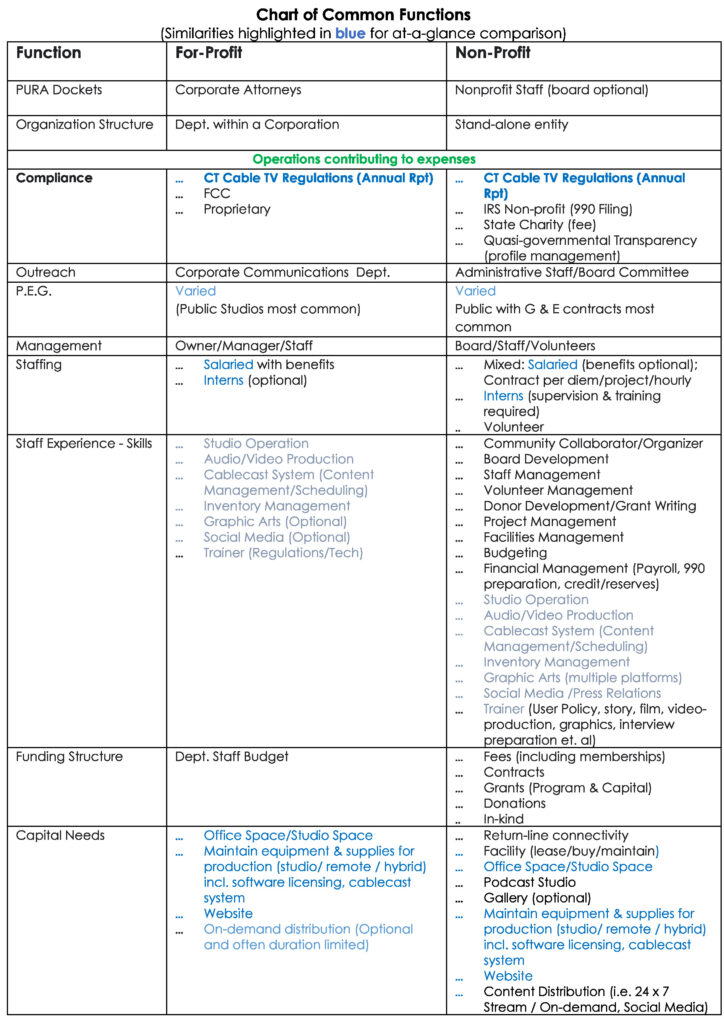Study with intent to change the delivery of community media in CT
Describe and discuss the current funding structures for both community access organizations’ operational and capital needs, including the similarities and differences in the operations and funding structures of non-profit and for-profit community access provide?
Special Act 22-23 mandates a study be conducted by PURA | NONPROFIT COMMUNITY ACCESS TELEVISION IN CT |1st Question to all participants
DISCUSSION OF ‘AS IS’ SCENARIO FOR OPERATION & FUNDING COMMUNITY MEDIA IN CT
Nonprofits are interested in providing what people cannot provide for themselves. Some have expanded their capacity to be media centers. For-profits are interested in meeting the minimum required for regulatory compliance. For evidence, review who remained open during COVID. Who did more, differently? Testimony from Nutmeg TV included an exploration of what is, or is not available, from For-Profit Community TV in CT (Download from here.)
Understanding what community TV is, is foundational to understanding funding structures.
WHAT IS P.E.G? COMMUNITY ACCESS TELEVISION? COMMUNITY MEDIA?
A majority of CT residents have no idea that there are laws, regulations, and grandfathered agreements to use public rights of way for the commercial carriage of television content. Or, that within these arrangements with broadband companies (formerly cable TV); there is mandatory support for alternative content: Theirs.
Public, Education, and Government Access (P.E.G) is noncommercial content created by and for people within a community to be carried on cable TV. While some content can be of interest to more people than those residing in the geographic area served, the emphasis within each component of P.E.G. is expected to be local.
(P) Individuals and groups’ ideas, information, and opinions as well as a showcase for local talent, (E) Content to enhance, augment or amplify local education resources, and (G) Meetings and related activities in support of transparency in government.
Community media is expected to be narrow: serving a variety of communities of interest i.e. culture, neighborhood, need, or a common goal, or interest, while simultaneously providing exposure to a community’s diversity and opportunities. As a platform for public engagement and an exchange of ideas, community television pre-dates the Public Internet @1983 and social media (early 2000s). Its regulations (1972, 1984, 1992) are rooted in the desire to preserve local 1 and be equitably distributed.
The language morphed from P.E.G. to ‘Community Access’ providing incremental clarity of the purpose: to provide a means of accessing one’s community by participating in its conversations, storytelling, and creation of archival records. Today, the term ‘cable TV’ appears most relevant in proceedings related to limiting the scope of funding for rights-of-way uses. And while first-play policies are in place for content produced with community media resources, funded in large part with subscriber cable fees, content distribution can be simultaneously over the internet, and redistributed over a variety of platforms. The content belongs to the producer. In fact, content viewing on alternate platforms including on-demand may exceed cable TV views much like other cable television. Financial support for other platforms may not be covered by cable subscriber fees.
Funding and Fundraising: The dilemma
Any conversations about how Community Media is currently funded, and the subscriber fee, may hit upon the following themes:
- A fee on the bill seems more like a tax than a lease-like cost for the companies.
- Why do I need to pay for P.E.G., if I do not care about it, or view it?
- We do not need another tax.
- The polls use everyone’s rights-of-way, why can’t I get the content too?
- Television is dying, so your funding will evaporate, but those polls are not going away, right?
- I thought I could not use the community TV studio because I do not have cable TV.
- How come I have never heard of this before? Should there be something in my bill?
- I checked the channel out. How come it does not look as clear as the others?
- How do I watch you? Oh, I do not have cable TV.
- I do not get how this all works. I have ideas and opinions but no interest in learning how to use a camera.
- How can I watch at a different time than scheduled? That has real value for me.
CT-SPECIFIC CATV INFRASTRUCTURE WIDENED CRACKS
It would help if you all were on the same page.
CT State Representative
The absence of county government inclines CT toward town-rule which has contributed, in part, to our patchwork community media delivery. Connecticut (CT) has the most complex, inequitable mechanism for providing (P.E.G) Access, and related funding, in the nation. This is ironic due to the appearance of universal availability and cost-effective centralized administration touted as the outcome of cable-company driven 1995 legislative changes.
Twenty-five years ago structural changes were made to community media in CT akin to constructing a highway through an inner city. There was a presumption of service to all with a guarantee of P.E.G. in every town in CT. However, the heart of community media, ‘The People’ for whom the tools & stage presumed to belong, were disenfranchised.
The appeal of technological innovation and personal freedom, which was originally called the community media advocates by name, is now under study. A study, in retrospect, was needed in 1995 when the seismic shift was codified. The discontinuance of franchise renewals further exacerbated the ‘disconnect’ with communities. The few remaining knowledgeable advocates are aging out of a system that is not designed to serve the media makers of today and the future. And those most familiar with the purpose are invested differently.
Other states in the northeast continue to have cable franchises centralized in population-dense areas serving surrounding communities. The cable access providers work together on a variety of operational and policy matters having no infrastructure-infused competition for funding. These arrangements, similarly impacted by the decline in cable subscriptions, have a base funding structure that at a minimum is 250% more than CT.
Most of the nonprofits which have affiliated around a push for change in the funding mechanisms in CT are not active in the national Alliance For Community Media (ACM). ACM is an educational, advocacy, and lobbying member organization that represents P.E.G. organizations and community media centers throughout the country. CT’s 1995 statewide regulatory changes lessened the advocacy potential of this professional alliance.
In reality, ours is a hodgepodge of corporate, regional, town, and mixed-service applications with a variety of channel capacity allocations and decades-old benchmarks for capacity, function, and service.
There is an easy way to determine who and where your community TV station is. While every community has been guaranteed the service, there is no public reference with every town identified and the affiliated community television station, not even on PURA’s website. In Wallingford, the town government refuses to include any reference to WPAA-TV on its website exacerbating this hidden-from-view scenario further.
There is also no easy way to search, and find existing community TV channels and the affiliated cable access providers and facilities. The Comcast TV Channel Guide does not refer to community access as such. The channel descriptions are ‘Local’, ‘Educational Programming’, and ‘Government Access Programming’ respectively. P.E.G channels are no longer guaranteed to be grouped together.
OUTCOME: A LACK OF CONSENSUS
On at least two occasions, CT has seen self-appointed CAP alliances emerge, fostered by declining subscriber fee funding challenges. The most impactful were those aligning to support funding for technology that evolved into the passage of PEGPETIA (not supported by all CAPs). The most recent was the alliance called “Regional Community Access Providers” whose legislative initiatives (seeking streaming media fees) eventuated into this study. In some ways this ‘out if the designated structure’ advocacy begs the question, what is the role of Advisory Councils?
Uniquely tribal, CT nonprofit CAPs (designated and independent) exist on a starvation diet and compete for scarce capital improvement funds in an unpredictable cycle-driven, regulated landscape a.k.a. PEGPETIA. Survival requires putting hyperlocal, territorial interests above collaborative considerations.
A few negative impacts:
- Channel Capacity Inequity: Three TV Channels can serve a small town such as No. Branford, or the combined urban communities of New Haven, Hamden, and West Haven.
- Capital investments are purchased at a premium with the inability to leverage sales and discounts.
- The ‘no reimbursement’ policy of capital funding restricts purchase timelines and strategic planning such as relocation which requires the implementation of a new return line.
- Strategic efforts have been challenged by cycles, sweeps, and caps.
- Some technology vendors maximize the funding cycle blips.
- Industry technology is HD, or better, but channel transmission capacity is SD
For more information: https://wpaa.tv/if-nothing-but-consistent/ Sept 22 What Are We Trying To Solve? CT Community Media?
- The Federal Communications Commission first established rules in 1965 for cable systems that received signals from microwave antennas. In 1966, the Commission established rules for all cable systems (whether or not served by microwave). The Supreme Court affirmed the Commission’s jurisdiction over cable in United States v. Southwestern Cable Co., 392 U.S. 157 (1968). The Court ruled that “the Commission has reasonably concluded that regulatory authority over CATV is imperative if it is to perform with appropriate effectiveness certain of its responsibilities.” The Court found the Commission needed authority over cable systems to assure the preservation of local broadcast service and to effect an equitable distribution of broadcast services among the various regions of the country.
- Interested in the cable company perspective: Docket Response from NECTA here.
- A comparison of the company versus nonprofit structure and operations expectations follows.


